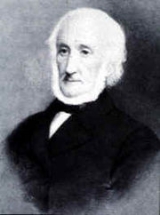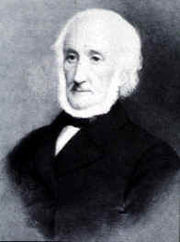
George Petrie
Encyclopedia

Ireland
Ireland is an island to the northwest of continental Europe. It is the third-largest island in Europe and the twentieth-largest island on Earth...
painter
Painting
Painting is the practice of applying paint, pigment, color or other medium to a surface . The application of the medium is commonly applied to the base with a brush but other objects can be used. In art, the term painting describes both the act and the result of the action. However, painting is...
, musician
Musician
A musician is an artist who plays a musical instrument. It may or may not be the person's profession. Musicians can be classified by their roles in performing music and writing music.Also....* A person who makes music a profession....
, antiquary and archaeologist of the Victorian era
Victorian era
The Victorian era of British history was the period of Queen Victoria's reign from 20 June 1837 until her death on 22 January 1901. It was a long period of peace, prosperity, refined sensibilities and national self-confidence...
.
Personal life
George Petrie was born in Dublin, Ireland, and grew up there, living at 21 Great Charles Street just off Mountjoy Square. He was the son of the portrait and miniature painter James Petrie, a native of Aberdeen, Scotland, who had settled in Dublin. He was interested in art from an early age. He was sent to the Dublin Society'sRoyal Dublin Society
The Royal Dublin Society was founded on 25 June 1731 to "to promote and develop agriculture, arts, industry, and science in Ireland". The RDS is synonymous with its main premises in Ballsbridge in Dublin, Ireland...
Schools, being educated as an artist, where he won the silver medal in 1805, aged fourteen.
Career
After an abortive trip to EnglandEngland
England is a country that is part of the United Kingdom. It shares land borders with Scotland to the north and Wales to the west; the Irish Sea is to the north west, the Celtic Sea to the south west, with the North Sea to the east and the English Channel to the south separating it from continental...
in the company of Francis Danby
Francis Danby
Francis Danby was an Irish painter of the Romantic era. His imaginative, dramatic landscapes were comparable to those of John Martin. Danby initially developed his imaginative style while he was the central figure in a group of artists who have come to be known as the Bristol School...
and James Arthur O'Connor
James Arthur O'Connor
James Arthur O'Connor was an Irish painter.-Career:James Arthur O'Connor was born 15 Aston's Quay, Dublin – the son of an engraver and printer, William O'Connor. O'Connor would become a distinguished landscape painter. He was self-taught, receiving just a few lessons from William Sadler...
, both of whom were close friends of his, he returned to Ireland where he worked mostly producing sketches for engravings for travel books – including among others, George Newenham Wright
George Newenham Wright
George Newenham Wright, , was an Irish writer and Anglican clergyman. He was born in Dublin; his father, John Thomas was a doctor. He graduated B.A. from Trinity College in 1814 and M.A. in 1817...
's guides to Killarney, Wicklow and Dublin, Thomas Cromwell
Thomas Cromwell (minister)
-Life:Born on 14 December 1792, at an early age he entered the literary department of Messrs. Longmans, the publishers.Brought up a member of the Church of England, of which his elder brother was a clergyman, Cromwell became about 1830 a Unitarian; and, being ordained, was from 1839 minister of...
's Excursions through Ireland, and James Norris Brewer
James Norris Brewer
James Norris Brewer , was an English topographer and novelist.Brewer was the eldest son of a merchant of London. He wrote many romances and topographical compilations, the best of the latter being his contributions to the series called the 'Beauties of England and Wales.' All the former are now...
's Beauties of Ireland.
In the late 1820s and 1830s, Petrie significantly revitalised the Royal Irish Academy
Royal Irish Academy
The Royal Irish Academy , based in Dublin, is an all-Ireland, independent, academic body that promotes study and excellence in the sciences, humanities and social sciences. It is one of Ireland's premier learned societies and cultural institutions and currently has around 420 Members, elected in...
's antiquities committee. He was responsible for their acquisition of many important Irish manuscripts, including an autograph copy of the Annals of the Four Masters
Annals of the Four Masters
The Annals of the Kingdom of Ireland or the Annals of the Four Masters are a chronicle of medieval Irish history...
, as well as examples of insular metalwork, including the Cross of Cong
Cross of Cong
The Cross of Cong is an early 12th century Irish Christian ornamented cusped processional cross, which was, as an inscription says, made for Tairrdelbach Ua Conchobair , King of Connacht and High King of Ireland to donate to the Cathedral church of the period that was located at Tuam, County...
. His writings on early Irish archaeology and architecture were of great significance, especially his Essay on the Round Towers of Ireland, which appeared in his 1845 book titled The Ecclesiastical Architecture of Ireland. He is often called "the father of Irish archaeology". His survey of the tombs at Carrowmore
Carrowmore
Carrowmore, County Sligo is one of the four major passage tomb cemeteries in Ireland. It is located at the centre of a prehistoric ritual landscape on the Cúil Irra Peninsula in County Sligo in Ireland....
still informs study of the site today.
From 1833 to 1843 he was employed by Thomas Colby
Thomas Frederick Colby
Thomas Frederick Colby , a British major-general and director of the Ordnance Survey , was born at St. Margaret's, Rochester, Kent, England, as a member of a South Wales family. Entering the Royal Engineers he overcame the loss of one hand in a shooting accident to begin in 1802 a lifelong...
and Thomas Larcom
Thomas Larcom
Major-General Sir Thomas Aiskew Larcom, 1st Baronet PC FRS was a leading official in the early Irish Ordnance Survey that started in 1824...
as head of the Topographical Department (the antiquities division) of the Irish Ordnance Survey
Ordnance Survey Ireland
Ordnance Survey Ireland is the national mapping agency of the Republic of Ireland and, together with the Ordnance Survey of Northern Ireland , succeeded, after 1922, the Irish operations of the United Kingdom Ordnance Survey. It is part of the Public service of the Republic of Ireland...
. Amongst his staff were John O'Donovan
John O'Donovan (scholar)
John O'Donovan , from Atateemore, in the parish of Kilcolumb, County Kilkenny, and educated at Hunt's Academy, Waterford, was an Irish language scholar from Ireland.-Life:...
, one of Ireland's greatest ever scholars, and Eugene O'Curry
Eugene O'Curry
-Life:He was born at Doonaha, near Carrigaholt, County Clare, the son of Eoghan Ó Comhraí, a farmer, and his wife Cáit. Eoghan had spent some time as a travelling pedlar and had developed an interest in Irish folklore and music. Unusually for someone of his background, he appears to have been...
. During part of this time Petrie was editor of two popular antiquarian magazines, the Dublin Penny Journal and, later, the Irish Penny Journal.
Another major contribution of Petrie's to Irish culture was the collection of Irish airs and melodies which he recorded. William Stokes's contemporary biography includes detailed accounts of Petrie's working methods in his collecting of traditional music: 'The song having been given, O'Curry wrote the Irish words, when Petrie's work began. The singer recommenced, stopping at a signal from him at every two or three bars of the melody to permit the writing of the notes, and often repeating the passage until it was correctly taken down . . .'
As an artist, his favourite medium was watercolour which, due to the prejudices of the age, was considered inferior to oil painting
Oil painting
Oil painting is the process of painting with pigments that are bound with a medium of drying oil—especially in early modern Europe, linseed oil. Often an oil such as linseed was boiled with a resin such as pine resin or even frankincense; these were called 'varnishes' and were prized for their body...
. Nonetheless, he can be considered as one of the finest Irish Romantic
Romanticism
Romanticism was an artistic, literary and intellectual movement that originated in the second half of the 18th century in Europe, and gained strength in reaction to the Industrial Revolution...
painters of his era. Some of his best work is in the collections of the National Gallery of Ireland
National Gallery of Ireland
The National Gallery of Ireland houses the Irish national collection of Irish and European art. It is located in the centre of Dublin with one entrance on Merrion Square, beside Leinster House, and another on Clare Street. It was founded in 1854 and opened its doors ten years later...
, such as his watercolour painting Gougane Barra Lake with the Hermitage of St. Finbarr, Co. Cork, 1831.

